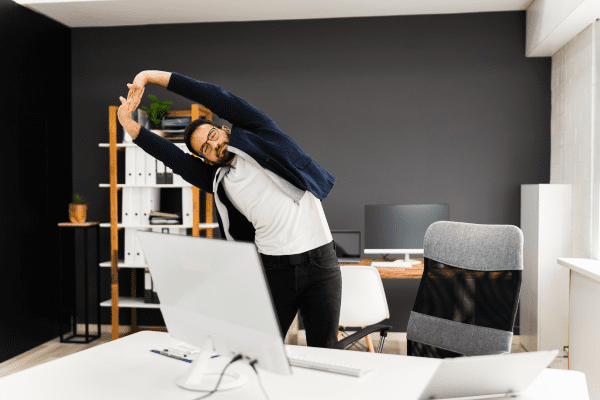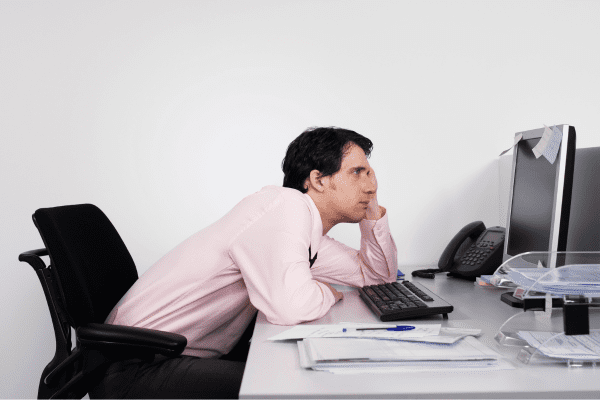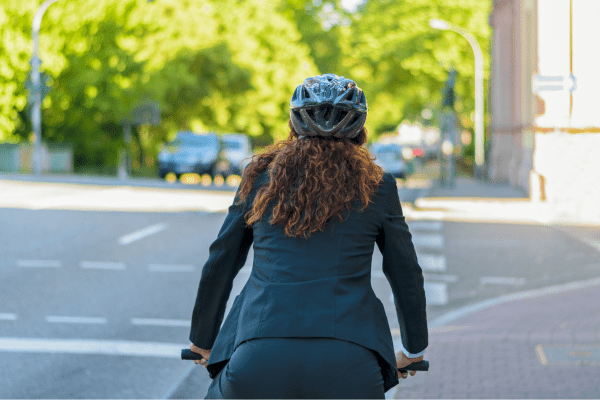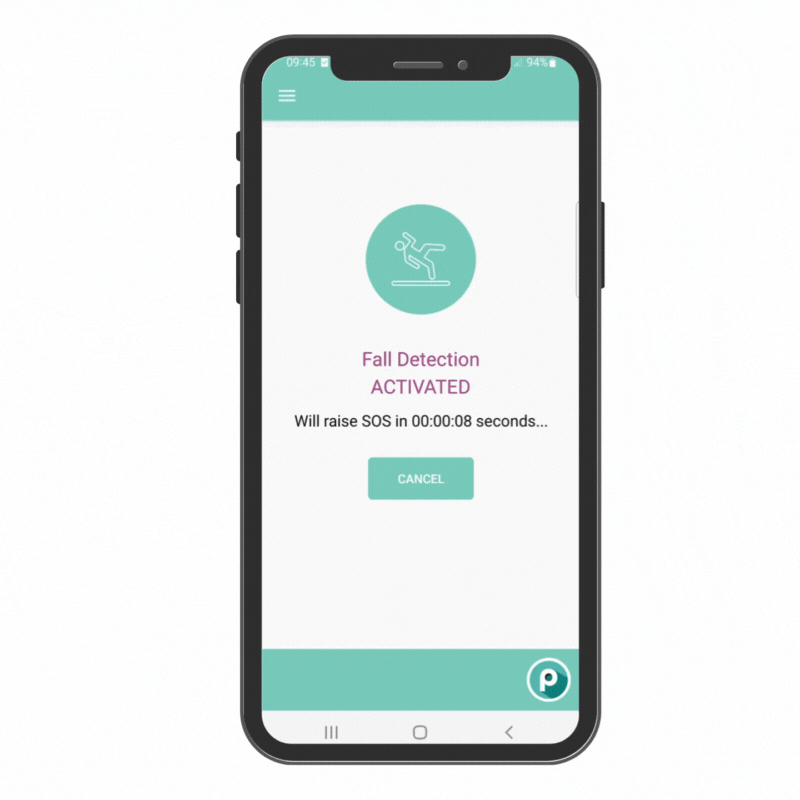Get a move one! How being mobile can help prevent slips, trips and falls at work
Slips, trips and falls are consistently recorded as being one of the most common cause of serious injury in the workplace. And the fact that many roles involve sitting for hours on end each day doesn’t help.
This is not a new discovery, but maybe we need more incentive to incorporate movement more into our day. In this blog, we breakdown:
- Why moving more helps prevent falls
- How remaining sedentary can contribute to them
- And ways in which you can get your workforce moving to improve their health and lessen the risks.
Why moving more prevents falls
Moving more can help prevent falls by improving strength, balance, and coordination, which are essential factors in maintaining stability and preventing accidents.
The list of benefits isn’t quite endless, but as you’ll see, it’s pretty extensive! You’ll see that moving more helps prevent falls, even if you have a wobble, and can decrease the risk of a more serious injury if you do lose the battle with gravity:
Here’s how increased physical activity and movement contribute to fall prevention:

Strengthens Muscles: Regular physical activity, such as strength training and resistance exercises, can help build and maintain muscle strength. Strong muscles are better able to support your body and keep you steady when walking or standing.
Improves Balance: Activities like yoga, Tai Chi, and balance exercises challenge your balance and coordination. Practising these activities can help you become more aware of your body’s position and improve your ability to react to changes in balance, reducing the risk of falling.
Enhances Coordination: Engaging in activities that require coordination, such as dancing or certain sports, can improve your overall coordination. This can help you navigate obstacles and uneven surfaces more effectively.
Maintains Bone Density: Weight-bearing activities, such as walking, jogging, or resistance training, help maintain bone density. Stronger bones are less likely to fracture in the event of a fall.
Increases Flexibility: Stretching and flexibility exercises can help you maintain your range of motion in joints and muscles, making it easier to move around and react to unexpected situations.
Boosts Cardiovascular Health: Regular aerobic exercise, like brisk walking or swimming, improves cardiovascular fitness. A strong heart and efficient circulation are important for maintaining consciousness and reacting to balance challenges.
Promotes Cognitive Function: Physical activity has been shown to have a positive impact on cognitive function. It can improve your ability to make quick decisions and react appropriately when you encounter a fall risk.
Weight Management: Maintaining a healthy weight through physical activity can reduce the stress on your joints and lower the risk of falls.
Enhances Confidence: Regular physical activity can increase your self-confidence and reduce the fear of falling. When you are more confident in your physical abilities, you are less likely to experience anxiety or hesitation when moving around.
Better Reaction Time: Regular exercise can improve your reflexes and reaction time, which can be crucial in preventing falls. You’ll be more prepared to catch yourself or respond quickly to a balance-threatening situation.

How remaining sedentary can heighten your risk of a fall
While moving more can lessen your chances of having a fall, sitting for extended periods during the day can have several negative effects on your physical and mental health.
This, in turn, can heighten your risk of taking a tumble.
Muscle Weakness: When you sit for extended periods, the muscles in your lower body, especially your legs and glutes can become weak and less engaged. Weak muscles may struggle to support your body weight and maintain balance when you eventually stand up and start moving. This can lead to instability and an increased risk of falling.
Reduced Joint Flexibility: Prolonged sitting can cause joints, particularly in the hips and knees, to become stiff and less flexible. Limited joint mobility can impair your ability to adapt to uneven surfaces or sudden movements, making it easier to trip or stumble.
Diminished Sensory Feedback: When sitting, you have less sensory feedback from your feet and legs compared to when you are standing or walking. This reduced sensory input can make it harder to detect changes in terrain or obstacles in your path, increasing the likelihood of losing your balance.
Delayed Reaction Time: Sitting for a long time can lead to muscle stiffness and reduced blood circulation. This can result in slower reaction times when you transition from sitting to standing or when you need to react quickly to a balance-threatening situation.
Balance Challenges: Sitting for extended periods can affect your proprioception, which is your sense of where your body is in space. When you stand up after sitting for a long time, your body may need a moment to readjust, potentially leading to balance issues and an increased risk of falling.
Orthostatic Hypotension: Prolonged sitting can contribute to orthostatic hypotension, a drop in blood pressure that occurs when you stand up quickly. This sudden drop in blood pressure can cause dizziness and increase the risk of falling, especially in older adults.
Reduced Muscle Activation: Sitting for prolonged periods can result in “muscle amnesia,” where certain muscles become inactive or fail to engage as effectively. This can hinder your ability to stabilise your body when you stand and move.
Impaired Bone Density: Prolonged sitting can negatively impact bone density, particularly in weight-bearing bones like the spine and hips. Weakened bones are more susceptible to fractures in the event of a fall.
Ways to get your workforce moving
With all the plus points of moving and the clear negative impact of sitting down too much, how can you help your team build movement into their working day? There are plenty of ways, some which might suit your team better than others.
QUICK TIP: Trying to jump on all of these suggestions at once might not be the best approach. Start small by encouraging one or two new habits in your organisation and build up from there.

- Use a Standing Desk: A standing desk or a desk converter can allow employees to alternate between sitting and standing throughout the day.
- Encourage Regular Breaks: You could create a series of reminders in your employees calendars to stand up, stretch, and move around for a few minutes every hour.
- Active Commuting: If your employees live relatively close to work, look at incentives to coax them into walking or biking to the office.
- Lunchtime Walks: Does your organisation stipulate time for a lunch break? Even a 15-30 minute walk can help refresh your employees mind and add some physical activity to their day.
- Desk Exercises: While you’re adding “active time” into your employees calendars, why not add in some instructions for simple exercises at their desk, such as leg lifts, seated marches, or desk push-ups. These exercises can help keep their muscles engaged and improve circulation.
- Active Meetings: Introduce walking meetings with colleagues when discussing ideas or projects. Walking and talking can be productive and provide a break from sitting.
- Exercise Ball Chair: See if you have employees who would like to have a go using an exercise ball as their chair. Sitting on an unstable surface can engage core muscles and promote better posture.
- Use Technology: Signpost your team to an app that can remind you to move regularly, track your steps, and encourage physical activity at work.
- Lunchtime Fitness Classes: Could you bring fitness classes into the office? Your team might thank you when they don’t have to shoehorn in a pre-work gym session and they can enjoy a lie in!
- Encourage a Healthy Work Environment: Advocate for a workplace culture that promotes movement and physical activity. This can include initiatives like wellness challenges, group fitness activities, or gym access.
Remember that consistency is key. Small, frequent movements throughout the day can add up to significant health benefits over time. Find strategies that work best for your specific work environment to help your workforce stay active and healthy in a sedentary role.
The quick way to get help when someone falls
If you have team member working on their own, it’s vital you ask yourself what would happen if they were to fall. Not getting the help they need quickly can lead to a worse injury. Fall Detection comes as standard on our PG Smart App, which costs up to £5 a month per licence. The algorithm detects:
- A change in orientation
- An impact
- A period of non-movement
Users have 30 seconds to cancel an activated fall detection before an SOS is raised, in case it was a false alarm, or they’re feeling fine after a tumble. The SOS goes to either our partner operators or your own team, so users can get the medical attention they need quickly, as the app shares their location.
Find out more about this and other PG Smart features in our blog.

